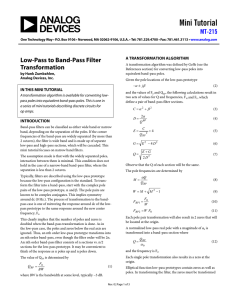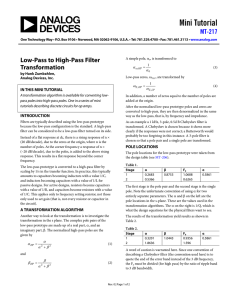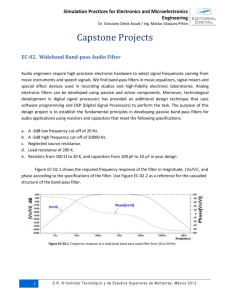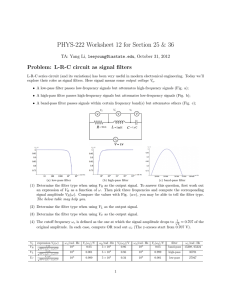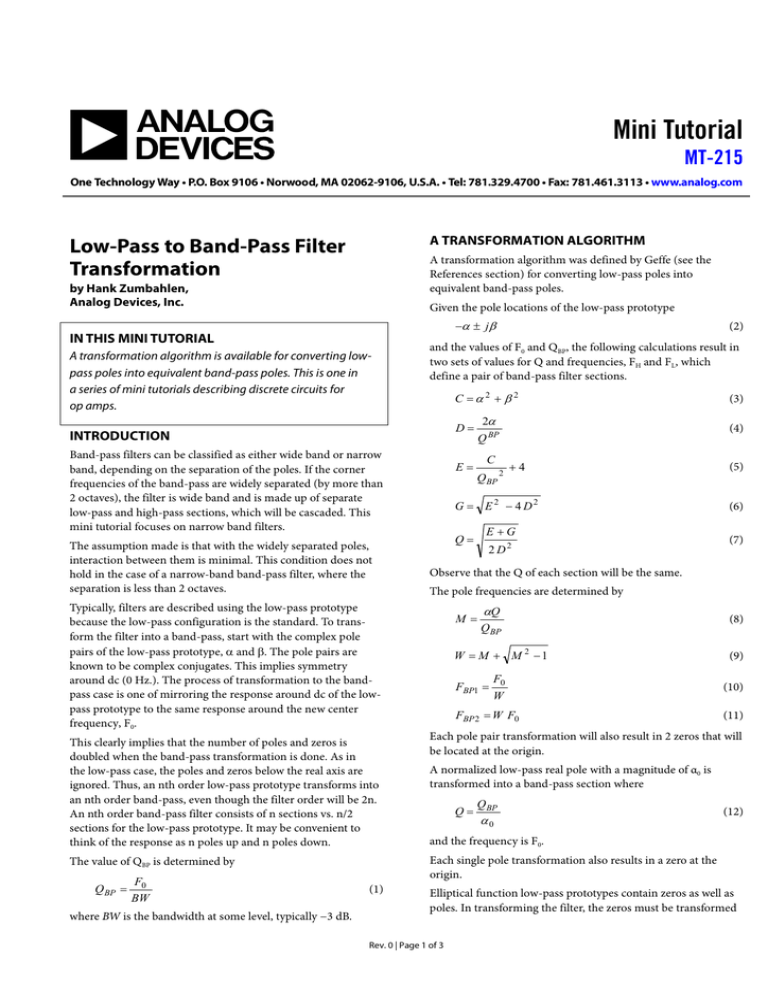
Mini Tutorial
MT-215
One Technology Way • P.O. Box 9106 • Norwood, MA 02062-9106, U.S.A. • Tel: 781.329.4700 • Fax: 781.461.3113 • www.analog.com
A TRANSFORMATION ALGORITHM
Low-Pass to Band-Pass Filter
Transformation
A transformation algorithm was defined by Geffe (see the
References section) for converting low-pass poles into
equivalent band-pass poles.
by Hank Zumbahlen,
Analog Devices, Inc.
Given the pole locations of the low-pass prototype
−α ± jβ
IN THIS MINI TUTORIAL
A transformation algorithm is available for converting lowpass poles into equivalent band-pass poles. This is one in
a series of mini tutorials describing discrete circuits for
op amps.
and the values of F0 and QBP, the following calculations result in
two sets of values for Q and frequencies, FH and FL, which
define a pair of band-pass filter sections.
C =α 2 + β 2
Band-pass filters can be classified as either wide band or narrow
band, depending on the separation of the poles. If the corner
frequencies of the band-pass are widely separated (by more than
2 octaves), the filter is wide band and is made up of separate
low-pass and high-pass sections, which will be cascaded. This
mini tutorial focuses on narrow band filters.
Typically, filters are described using the low-pass prototype
because the low-pass configuration is the standard. To transform the filter into a band-pass, start with the complex pole
pairs of the low-pass prototype, α and β. The pole pairs are
known to be complex conjugates. This implies symmetry
around dc (0 Hz.). The process of transformation to the bandpass case is one of mirroring the response around dc of the lowpass prototype to the same response around the new center
frequency, F0.
This clearly implies that the number of poles and zeros is
doubled when the band-pass transformation is done. As in
the low-pass case, the poles and zeros below the real axis are
ignored. Thus, an nth order low-pass prototype transforms into
an nth order band-pass, even though the filter order will be 2n.
An nth order band-pass filter consists of n sections vs. n/2
sections for the low-pass prototype. It may be convenient to
think of the response as n poles up and n poles down.
F0
BW
where BW is the bandwidth at some level, typically −3 dB.
E=
(4)
Q BP
C
Q BP 2
+4
G = E 2 − 4 D2
E +G
Q=
(3)
2 D2
(5)
(6)
(7)
Observe that the Q of each section will be the same.
The pole frequencies are determined by
M=
αQ
Q BP
(8)
W = M + M 2 −1
(9)
F0
W
(10)
FBP1 =
FBP 2 = W F0
(11)
Each pole pair transformation will also result in 2 zeros that will
be located at the origin.
A normalized low-pass real pole with a magnitude of α0 is
transformed into a band-pass section where
Q=
Q BP
α0
(12)
and the frequency is F0.
Each single pole transformation also results in a zero at the
origin.
The value of QBP is determined by
Q BP =
2α
D=
INTRODUCTION
The assumption made is that with the widely separated poles,
interaction between them is minimal. This condition does not
hold in the case of a narrow-band band-pass filter, where the
separation is less than 2 octaves.
(2)
(1)
Elliptical function low-pass prototypes contain zeros as well as
poles. In transforming the filter, the zeros must be transformed
Rev. 0 | Page 1 of 3
MT-215
Mini Tutorial
POLE LOCATIONS
as well. Given the low-pass zeros at ± jωZ , the band-pass zeros
are obtained as follows:
(13)
Q BP
Table 1.
W = M + M −1
(14)
F0
W
(15)
2
FBP1 =
FBP 2 = W F0
(16)
Since the gain of a band-pass filter peaks at FBP instead of F0, an
adjustment in the amplitude function is required to normalize
the response of the aggregate filter. The gain of the individual
filter section is given by:
AR = A0
The pole locations for the LP prototype were taken from the
design table (see MT-206). They are outlined in Table 1.
F
F
1 + Q 2 0 − BP
F0
FBP
2
(17)
where:
A0 = gain a filter center frequency
AR = filter section gain at resonance
F0 = filter center frequency
FBP = filter section resonant frequency
Stage
1
2
α
0.2683
0.5366
β
0.8753
F0
1.0688
0.6265
α
0.5861
The first stage is the pole pair and the second stage is the single
pole. Note the unfortunate convention of using α for two
entirely separate parameters. The α and β on the left are the
pole locations in the s-plane. These are the values used in the
transformation algorithms. The α on the right is 1/Q, which is
what the design equations for the physical filters want to see.
Part of the transformation process is to specify the 3 dB
bandwidth of the resultant filter. In this case, this bandwidth
will be set to 500 Hz. The results of the transformation yield
results as shown in
Table 2.
Stage
1
2
3
The low-pass prototype is now converted to a band-pass filter.
The equation string outlined above is used for the transformation. Each pole of the prototype filter transforms into a
pole pair. Therefore, the 3-pole prototype, when transformed,
will have 6 poles (3 pole pairs). In addition, there will be 6 zeros
at the origin.
F0
804.5
1243
1000
Q
7.63
7.63
3.73
A0
3.49
3.49
1
The reason for the gain requirement for the first two stages is
that their center frequencies will be attenuated relative to the
center frequency of the total filter. Since the resultant Qs are
moderate (less than 20) the multiple feedback topology will be
chosen (see MT-218).
Figure 1 is the schematic of the filter and Figure 2 shows the
frequency response.
OUT
301kΩ
0.01µF
IN
0.01µF
0.01µF
0.01µF
118kΩ
0.01µF
59kΩ
28kΩ
43.2kΩ
1.33kΩ
196kΩ
0.01µF
2.21kΩ
866Ω
Figure 1. Band-Pass Transformation
Rev. 0 | Page 2 of 3
10420-001
M =
αQ
Mini Tutorial
MT-215
0
RESPONSE (dB)
–5
–10
–20
0.3
1.0
FREQUENCY (kHz)
3.0
10420-002
–15
Figure 2. Band-Pass Filter Response
Note that again there is symmetry around the center frequency. In addition, the 500 Hz bandwidth is not 250 Hz either side of the center
frequency (arithmetic symmetry). Instead, the symmetry is geometric, which means that any two frequencies (F1 and F2) of equal
amplitude are related by
F0 = F1 × F 2
(18)
REFERENCES
Geffe, P. R. "Designer’s Guide to Active Band-Pass Filters," EDN, Apr. 5 1974, pp. 46-52.
Zumbahlen, Hank. Linear Circuit Design Handbook. Elsevier. 2008. ISBN: 978-7506-8703-4.
REVISION HISTORY
3/12—Revision 0: Initial Version
©2012 Analog Devices, Inc. All rights reserved. Trademarks and
registered trademarks are the property of their respective owners.
MT10420-0-3/12(0)
Rev. 0 | Page 3 of 3
Click below to find more
Mipaper at www.lcis.com.tw
Mipaper at www.lcis.com.tw

